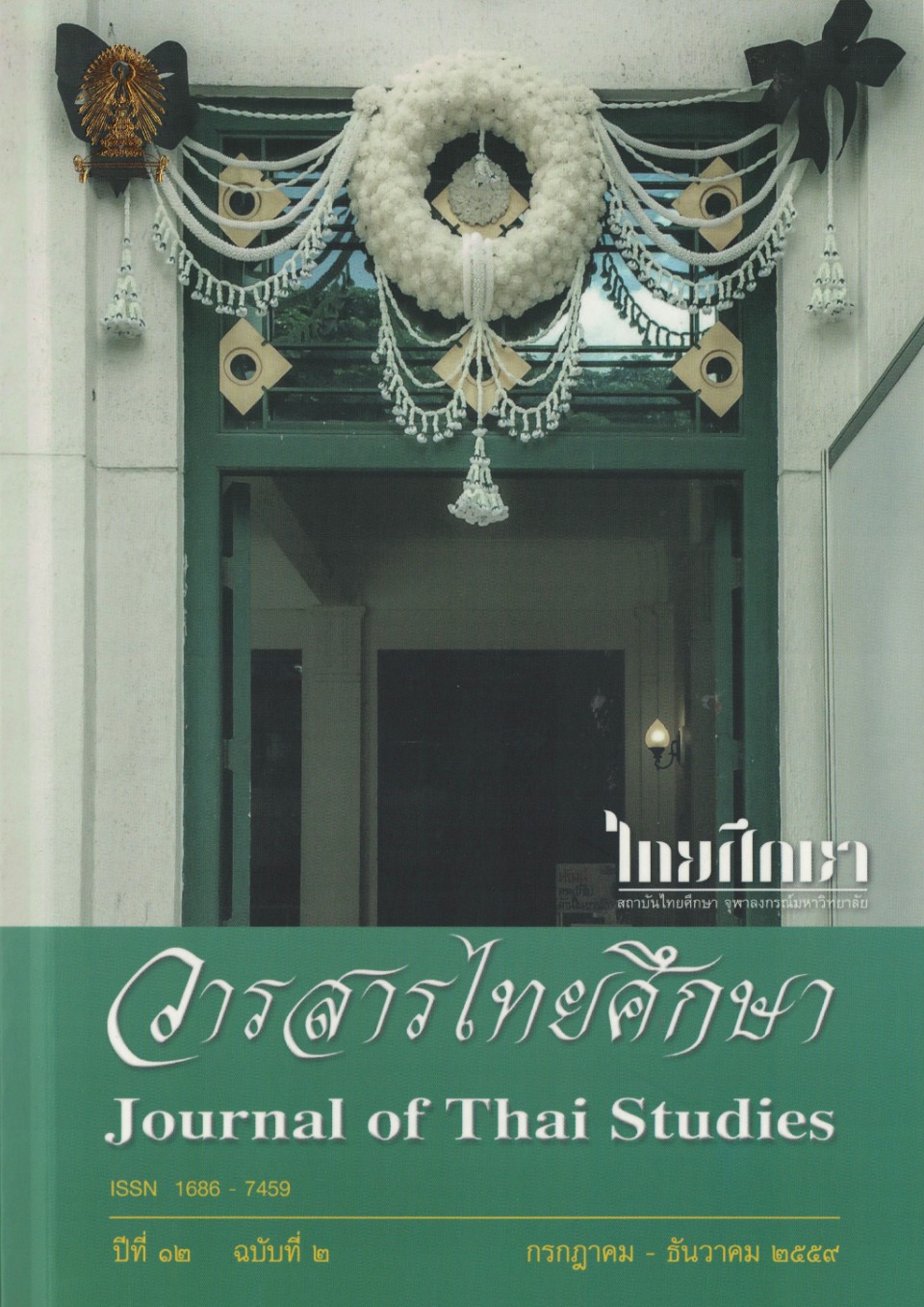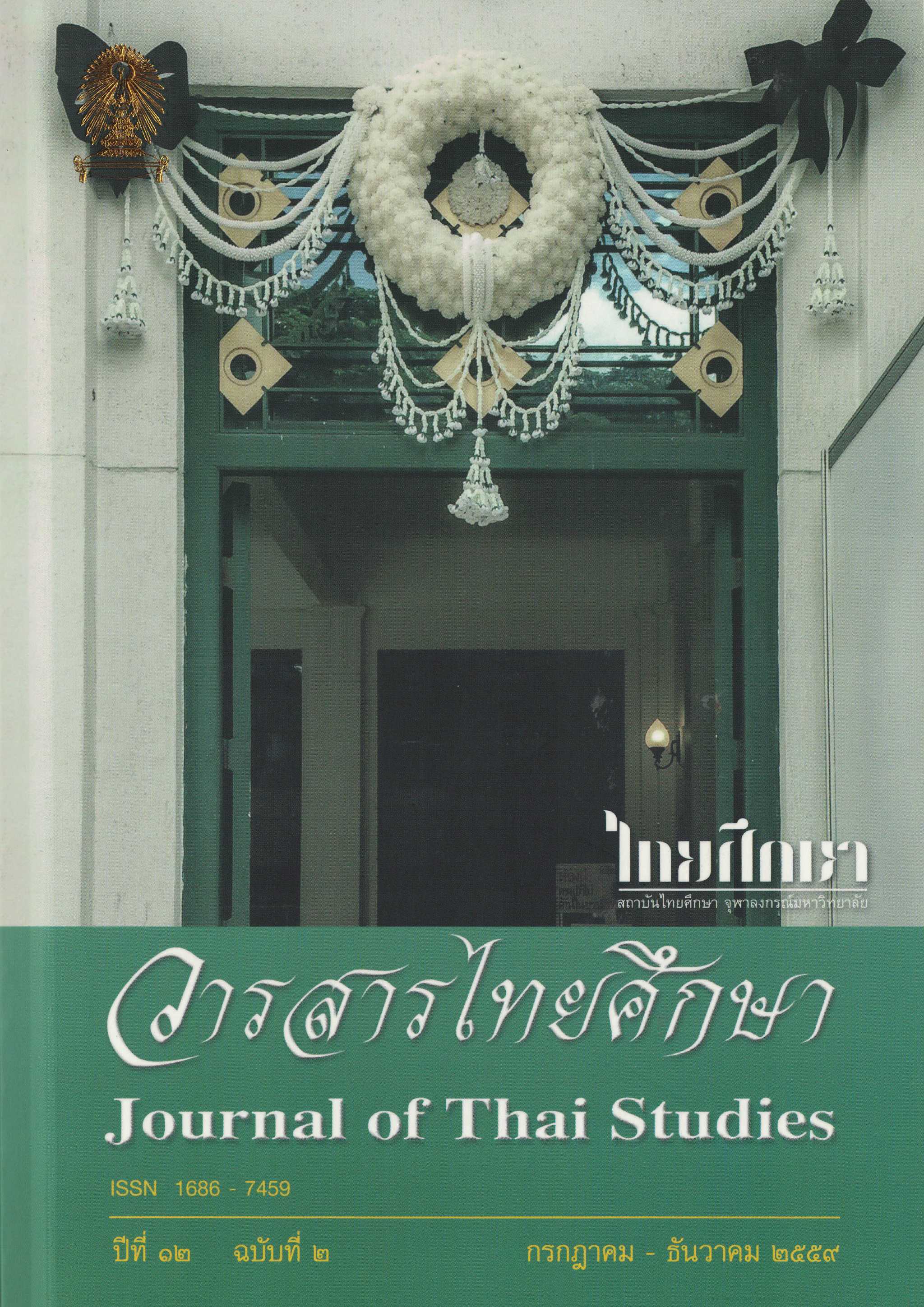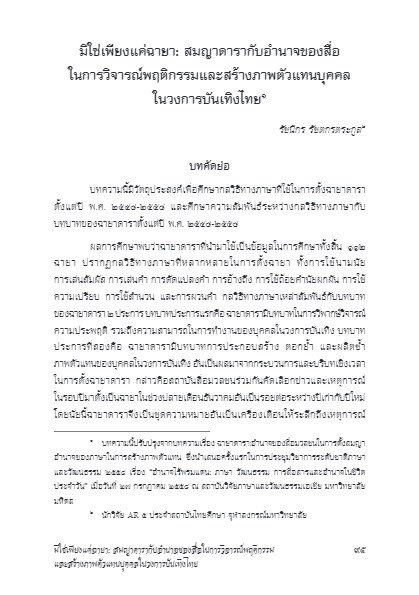วารสารไทยศึกษา - ปีที่ 12 ฉบับที่ 2

1) จากอวสานถึงเริ่มใหม่ : ยุคพระศรีอารียเมตไตรยในไตรภูมิฉบับหอสมุดแห่งชาติกรุงปารีส / ภัครพล แสงเงิน
2) “พุทธาวตาร” กับ “ทศรถชาดก” : พุทธในพราหมณ์-ฮินดู พราหมณ์-ฮินดูในพุทธ / แคทรียา อังทองกำเนิด
3) เสด็จประพาสต้น : การบันทึกกิจกรรมพักผ่อนหย่อนใจของชนชั้นนำสยามในสมัยรัชกาลที่ 5 / พรรณราย ชาญหิรัญ
4) คำกริยาที่แสดงการใช้มือกระทำในภาษาถิ่นเชียงราย / พรรณวดี รัตนศักดิ์, สุทธา รัตนศักดิ์
5) มิใช่เพียงแค่ฉายา : สมญาดารากับอำนาจสื่อในการวิจารณ์พฤติกรรมและสร้างภาพตัวแทนบุคคลในวงการบันเทิงไทย / รัชนีกร รัชตกรตระกูล
จากอวสานถึงเริ่มใหม่ : ยุคพระศรีอารียเมตไตรยในไตรภูมิฉบับหอสมุดแห่งชาติกรุงปารีส
ภัครพล แสงเงิน
บทคัดย่อ
บทความนี้มุ่งศึกษาเรื่องสัตถันตรกัลป์และยุคพระศรีอาริยเมตไตรยในไตรภูมิ ฉบับหอสมุดแห่งชาติกรุงปารีส โดยศึกษาเปรียบเทียบกับคัมภีร์ทางพระพุทธศาสนา 4 ฉบับ คือ 1. พระสุตตันตปิฎก ทีฆนิกาย ปาฏิกวรรค จักกวัตติสูตร 2. คัมภีร์พระอนาคตวงศ์ 3. คัมภีร์อมตรสธารา ฎีกาอนาคตวงศ์ และ 4. คัมภีร์พระสาวกนิพพาน ผลการศึกษาพบว่า เนื้อหาของเรื่องสัตถันตรกัลป์และยุคพระศรีอาริยเมตไตรยในไตรภูมิฉบับหอสมุดแห่งชาติกรุงปารีสมีความคล้ายคลึงกับคัมภีร์ทางพระพุทธศาสนาเป็นอย่างยิ่ง แสดงให้เห็นว่า ความเชื่อเรื่องสัตถันตรกัลป์ซึ่งเป็นเหตุการณ์สำคัญที่จะเกิดขึ้นเมื่อสิ้นยุคของพระพุทธเจ้าโคดม และการลงมาอุบัติของพระศรีอาริยเมตไตรยและพระยาสังขจักมหาจักรพรรดิราชยังคงเป็นความเชื่อที่ปรากฏในวรรณกรรมไตรภูมิสมัยอยุธยาอย่างชัดเจน
คำสำคัญ : พระศรีอาริยเมตไตรย, ไตรภูมิฉบับหอสมุดแห่งชาติกรุงปารีส
(ตีพิมพ์ใน วารสารไทยศึกษา ปีที่ 12 ฉบับที่ 2 (กรกฎาคม – ธันวาคม 2559) หน้า 1-15)
From the End to Begin: The Era of Ariyamettraiya Buddha in the National Library of Paris Edition of Traiphum
Phakphon Sangngern
Abstract
This article aims to investigate the Satthantaragalpa story and the era of Ariyamettraiya Buddha in the National Library of Paris edition of Traiphum by comparison with four Buddhism scriptures: Phra Tripitaka Cakkawattisutti; Anakghatawangsa Scripture; Amatarasadhara Tika Anagatawangsa; and Phra Sawaka Nibbhan Scripture. The study found that the Satthantaragalpa story and the era of Ariyamettraiya Buddha in this version of Traiphum were very similar with Buddhism scripture. This shows that belief in the Satthantaragalpa story, which is the most important story at the end of Gotama Buddha period and the birth of Ariyamettraiya Buddha and the emperor, Sankhachak, is a belief that can be found in the Ayutthaya Traiphum.
Keywords : Ariyamettraiya Buddha, The National Library of Paris edition of Traiphum
(Published in Journal of Thai Studies Volume 12 Number 2 (July – December 2016) Page 1-15)
บทความ / Full Text : Download
"พุทธาวตาร" กับ "ทศรถชาดก" : พุทธในพราหมณ์-ฮินดู พราหมณ์-ฮินดูในพุทธ
แคทรียา อังทองกำเนิด
บทคัดย่อ
บทความวิจัยนี้มีวัตถุประสงค์เพื่อศึกษาเรื่องเล่าเกี่ยวกับพระพุทธเจ้าในรูปพระนารายณ์อวตารหรือที่รู้จักกันในชื่อปางพุทธาวตาร และเรื่องเล่าเกี่ยวกับพระรามในรูปพระโพธิสัตว์ โดยศึกษาจากนารายณ์สิบปาง คำกาพย์เรื่องพระศิวประติมา และทสรถชาดก ผลการศึกษาพบว่า เรื่องเล่าเกี่ยวกับพระพุทธเจ้าในฐานะพระนารายณ์อวตารไม่ได้รับการยอมรับในปริบทสังคมไทยที่นับถือพุทธศาสนา ดังจะเห็นได้จากนารายณ์สิบปางฉบับต่างๆ ไม่ปรากฏชื่อปางพุทธาวตาร มีเพียงลิลิตนารายณ์สิบปางที่คงชื่อปางดังกล่าวไว้ แต่ไม่ได้ให้รายละเอียดใดๆ เกี่ยวกับปางนี้ เรื่องเล่าเกี่ยวกับพุทธาวตารปรากฏอีกครั้งในคำกาพย์เรื่องพระศิวประติมา แม้จะมีการกล่าวถึงเรื่องพุทธาวตาร แต่จะเห็นได้ว่าเรื่องราวที่ปรากฏเป็นไปในลักษณะการโต้ตอบความคิดเรื่องพระพุทธเจ้า คือพระนารายณ์อวตาร ส่วนเรื่องเล่าเกี่ยวกับพระรามในรูปพระโพธิสัตว์กลับได้รับการยอมรับในสังคมไทย เนื่องจากในทสรถชาดก พระรามพระผู้เป็นเจ้าในศาสนาพราหมณ์-ฮินดูได้รับการปรับเปลี่ยนฐานะให้กลายเป็นพระโพธิสัตว์หรือพระพุทธเจ้าพระชาติหนึ่ง และได้มีการปรับเปลี่ยนเรื่องเล่าเกี่ยวกับพระรามให้เข้ากับคติความคิดแบบพุทธศาสนา
คำสำคัญ : พุทธาวตาร, ทสรถชาดก, พระโพธิสัตว์
(ตีพิมพ์ใน วารสารไทยศึกษา ปีที่ 12 ฉบับที่ 2 (กรกฎาคม – ธันวาคม 2559) หน้า 17-39)
“Buddha Avatar” and the “Dasaratha Jataka” : Buddhism in Hinduism and Hinduism in Buddhism
Catthaleeya Aungthongkamnerd
Abstract
The purpose of this research is to examine the narratives that portray the Buddha as an avatar of Narayana (Vishnu) (also known as the Buddha Avatar) and the narratives that portray Phra Ram as a Bodhisattva. The texts chosen for analysis include Lilit Narai Sip Pang, the Verse of Shiva Pratima, and the Dasaratha Jataka. The analysis, on the one hand, reveals that the narratives that portray the Buddha as an avatar of Narayana (Vishnu) are not widely accepted in the context of Thai Buddhism. Among various versions of Narai Sip Pang, the Buddha Avatar only appears in Lilit Narai Sip Pang and no further details are given. This concept of the Buddha Avatar is also found in the Verse of Shiva Pratima, but it appears only in the form of a counter-narrative to the belief that the Buddha is really an avatar of Narayana (Vishnu). On the other hand, the narratives that portray Phra Ram as a Bodhisattva are more generally accepted in the religious context of Thai society. It is also found that in the Dasaratha Jataka, Phra Ram, one of the Hindu deities, was revised to be recognized as the Buddha in one of his previous lives. The narratives gradually were changed to adapted Phra Ram to conform to Buddhist beliefs.
Keywords : Buddha Avatar, the Dasaratha Jataka, Bodhisattva
(Published in Journal of Thai Studies Volume 12 Number 2 (July – December 2016) Page 17-39)
บทความ / Full Text : Download
เสด็จประพาสต้น : การบันทึกกิจกรรมพักผ่อนหย่อนใจของชนชั้นนำสยามในสมัยรัชกาลที่ 5
พรรณราย ชาญหิรัญ
บทคัดย่อ
บทความนี้มุ่งศึกษา พระราชนิพนธ์ เสด็จประพาสต้นครั้งที่ 2 ในแง่การบันทึกกิจกรรมพักผ่อนหย่อนใจของชนชั้นนำสยามในสมัยรัชกาลที่ 5 โดยเฉพาะความหมายทางวัฒนธรรมของกิจกรรมแต่ละอย่าง การพักผ่อนหย่อนใจแบบตะวันตกที่ชนชั้นนำสยามรับเข้ามาปฏิบัติแสดงถึงการตระหนักเรื่องความศิวิไลซ์ที่เริ่มก่อตัวในยุคสมัยนั้น กิจกรรมที่ปรากฏใน เสด็จประพาสต้น ได้แก่ การถ่ายรูป การปรุงและรับประทานอาหาร การท่องเที่ยวสำรวจตามสถานที่ต่าง ๆ การชมสิ่งของและคนที่มีลักษณะพิเศษ การชมละครนอกวัง การปฏิสันถารกับราษฎร รวมทั้งการปลอมพระองค์และบรรยากาศการรับเสด็จ การเสด็จประพาสต้นนี้ยืนยันสถานภาพของชนชั้นนำซึ่งแตกต่างกับคนกลุ่มอื่นในสังคม ผ่านกิจกรรมพักผ่อนหย่อนใจที่ปฏิบัติระหว่างการเดินทางรวมทั้งการเสด็จประพาสต้นเองในฐานะกิจกรรมพักผ่อนหย่อนใจแบบใหม่ที่สงวนไว้สำหรับชนชั้นนำเท่านั้น
คำสำคัญ : เสด็จประพาสต้น, การพักผ่อนหย่อนใจ, ชนชั้นนำสยาม
(ตีพิมพ์ใน วารสารไทยศึกษา ปีที่ 12 ฉบับที่ 2 (กรกฎาคม – ธันวาคม 2559) หน้า 41-63)
Sadet Praphatton: Recreational Activities of Siamese Court Elites during the Reign of King Chulalongkorn
Phannarai Chanhiran
Abstract
This article aims to study Sadet Praphatton, a personal account of a recreational journey during the reign of King Chulalongkorn. The analysis focuses on the cultural meaning of certain recreational activities. Siamese elites adopted Western recreational practices to implement the emerging concept of civilization. Sadet Praphatton includes description of various recreational activities and entertainment: photography; cooking and eating; experiencing exotic places, things and people; watching performance; engaging in conversation with commoners; self-disguise, and welcoming events. These recreational journeys enhanced the status of Siamese elites as distinguished from people of other social groups. Such recreational journeys per se were a new recreational activity exclusively consumed by the elites.
Keywords : Sadet Praphatton; recreation; Siamese elites
(Published in Journal of Thai Studies Volume 12 Number 2 (July – December 2016) Page 41-63)
บทความ / Full Text : Download
คำกริยาที่แสดงการใช้มือกระทำในภาษาถิ่นเชียงราย
พรรณวดี รัตนศักดิ์ และ สุทธา รัตนศักดิ์
บทคัดย่อ
การศึกษาครั้งนี้มีวัตถุประสงค์เพื่อจำแนกประเภทของคำกริยาที่แสดงการใช้มือกระทำในภาษาถิ่นเชียงราย โดยใช้ทฤษฎีวิเคราะห์องค์ประกอบทางความหมาย
ในการเก็บรวบรวมข้อมูล ผู้วิจัยเริ่มจากการกำหนดคำจำกัดความของคำกริยาที่แสดงการใช้มือกระทำ แล้วรวบรวมคำต่าง ๆ ที่อยู่ในกลุ่มความหมายเดียวกันกับคำข้างต้นจากพจนานุกรมล้านนา–ไทย จากนั้นนำข้อมูลที่ได้มาวิเคราะห์ตามวิธีวิเคราะห์องค์ประกอบทางความหมาย โดยพิจารณาจากความสัมพันธ์ระหว่างคำนามและคำกริยา(การก) เพื่อศึกษาความแตกต่างและสร้างส่วนประกอบของความหมายเฉพาะของแต่ละคำ แล้วจึงนำข้อมูลที่ได้จากการวิเคราะห์ไปตรวจสอบกับผู้บอกภาษาซึ่งเป็นคนที่เกิดและเติบโตในจังหวัดเชียงราย
ผลการศึกษาพบว่า คำกริยาที่แสดงการใช้มือกระทำในภาษาถิ่นเชียงรายสามารถจำแนกประเภทโดยใช้ทฤษฎีวิเคราะห์องค์ประกอบทางความหมายได้ 9 หมวด คือ หมวดกริยาที่ใช้มือรวบจับสิ่งใดสิ่งหนึ่งไว้ หมวดกริยาที่ใช้มือทำให้สิ่งที่ปิดอยู่เผยออก หมวดกริยาที่ใช้มือเอาบางอย่างออกจากที่เดิม หมวดกริยาที่ใช้มือทำให้บางอย่างสูงจากที่เดิม หมวดกริยาที่ใช้มือล้วงเข้าไปในบางสิ่งที่เป็นช่องหรือรูและอาจเอาหรือไม่เอาบางสิ่งที่อยู่ในนั้นออกมา หมวดกริยาที่มือเหนี่ยวหรือรั้งสิ่งใดสิ่งหนึ่งไว้ หมวดกิริยาที่ใช้มือทำให้บางอย่างเป็นรอย หมวดกริยาที่ใช้มือบังคับ หรือใช้กำลังกดสิ่งใดสิ่งหนึ่ง และหมวดกริยาที่ใช้มือแตะต้องสิ่งใดสิ่งหนึ่ง นอกจากนี้การศึกษาดังกล่าวยังสามารถจำแนกความแตกต่างของคำในแต่ละหมวดซึ่งมีความหมายใกล้เคียงกัน โดยสรุปเป็นคำจำกัดความของคำต่าง ๆ ได้
คำสำคัญ : คำกริยาที่ที่แสดงการใช้มือ, ภาษาถิ่นเชียงราย, ทฤษฎีวิเคราะห์องค์ประกอบทางความหมาย
(ตีพิมพ์ใน วารสารไทยศึกษา ปีที่ 12 ฉบับที่ 2 (กรกฎาคม – ธันวาคม 2559) หน้า 65-94)
A Semantics Study of Hand-Related Verbs in Chaingrai Dialect of Thai
Panwadee Rattanasak and Suttha Rattanasak
Abstract
This study aims at classifying types of hands-related verbs spoken in Chiang Rai dialects by using componential analysis.
For the data collection procedure, the researcher started with defining hands-related verbs and grouping them in accordance with the Lanna-Thai dictionary. Then, the data was analyzed using componential analysis by taking the interrelationship between nouns and verbs into consideration to study the differences and components of each word. The data was checked by language informants who were originally born and raised in Chiang Rai.
The study showed that hands-related verbs can be grouped into nine categories: hands-related verbs indicating how to hold something; hands-related verbs indicating how to uncover something; hands-related verbs indicating how to move something; hands-related verbs showing how to raise something; hands-related verbs showing how to grasp something in a hole or take something out, which may or may not take something out of the hole; hands-related verbs showing how to make a scratch; hands-related verbs showing how to control or press something; and hands-related verbs showing how to touch something. In addition, this study also showed the differences of words in each category which denotes their closely-related meanings.
Keywords : hands-related verbs , Chiang Rai dialects , componential analysis
(Published in Journal of Thai Studies Volume 12 Number 2 (July – December 2016) Page 65-94)
บทความ / Full Text : Download
มิใช่เพียงแค่ฉายา : สมญาดารากับอำนาจสื่อในการวิจารณ์พฤติกรรมและสร้างภาพตัวแทนบุคคลในวงการบันเทิงไทย
รัชนีกร รัชตกรตระกูล
บทคัดย่อ
บทความนี้มีวัตถุประสงค์เพื่อศึกษากลวิธีทางภาษาที่ใช้ในการตั้งฉายาดาราตั้งแต่ปี พ.ศ. 2548-2558 และศึกษาความสัมพันธ์ระหว่างกลวิธีทางภาษากับบทบาทของฉายาดาราตั้งแต่ปี พ.ศ. 2548-2558
ผลการศึกษาพบว่าฉายาดาราที่นำมาใช้เป็นข้อมูลในการศึกษาทั้งสิ้น 112 ฉายา ปรากฏกลวิธีทางภาษาที่หลากหลายในการตั้งฉายา ทั้งการใช้นามนัย การเล่นสัมผัส การเล่นคำ การดัดแปลงคำ การอ้างถึง การใช้ถ้อยคำนัยผกผัน การใช้ความเปรียบ การใช้สำนวน และการผวนคำ กลวิธีทางภาษาเหล่าสัมพันธ์กับบทบาทของฉายาดารา 2 ประการ บทบาทประการแรกคือ ฉายาดารามีบทบาทในการวิพากษ์วิจารณ์ความประพฤติ รวมถึงความสามารถในการทำงานของบุคคลในวงการบันเทิง บทบาท ประการที่สองคือ ฉายาดารามีบทบาทการประกอบสร้าง ตอกย้ำ และผลิตซ้ำ ภาพตัวแทนของบุคคลในวงการบันเทิง อันเป็นผลมาจากกระบวนการและบริบทเชิงเวลาในการตั้งฉายาดารา กล่าวคือสถาบันสื่อมวลชนร่วมกันคัดเลือกข่าวและเหตุการณ์ในรอบปีมาตั้งเป็นฉายาในช่วงปลายเดือนธันวาคมอันเป็นรอยต่อระหว่างปีเก่ากับปีใหม่ โดยนัยนี้ฉายาดาราจึงเป็นชุดความหมายอันเป็นเครื่องเตือนให้ระลึกถึงเหตุการณ์จากปีเก่า ที่พร้อมให้นำมาใช้ซ้ำในปีใหม่และปีต่อๆ ไป โดยมีสื่อสมัยใหม่เอื้อให้การเผยแพร่ชุดความหมายจากฉายาเป็นไปอย่างรวดเร็ว ในขณะเดียวกันก็เก็บรักษาชุดความหมายให้สืบค้นได้อย่างไม่รู้จบ
คำสำคัญ : ฉายา, สมญานาม, กลวิธีทางภาษา, ภาพตัวแทน, บุคคลในวงการบันเทิงไทย
(ตีพิมพ์ใน วารสารไทยศึกษา ปีที่ 12 ฉบับที่ 2 (กรกฎาคม – ธันวาคม 2559) หน้า 95-132)
Not Just a Nickname: Labels for Entertainers and the Media’s Power to Criticize the Behavior and Construct Representations of Entertainers
Ratchaneekorn Ratchatakorntrakoon
Abstract
This study aims to study the linguistic devices used for the construction of nicknames of Thai entertainers and to study the relationship between the linguistic devices in the role of assigning nicknames to Thai entertainers during 2005-2015.
The study reveals that there were several linguistic devices used for the construction of 112 labels during this period, namely; metonymy, assonance, puns, adaptation of words, allusions, verbal irony, metaphors, idioms, and spoonerisms. These linguistic devices relate to two roles in the assignment of nicknames to Thai entertainers. The first role is to criticize the behavior and performance of Thai entertainers. The second role is to construct, reinforce and reproduce the image of entertainers. The process – typically the selection of one event from the past year used as material for label construction – creates a nicknames of entertainers as a reminder of the event during the last year, which will continue to be used in the following year. Through social media, nicknames of entertainers are easily disseminated and preserved for repeated future searching.
Keywords : label, linguistic devices, representations, Thai entertainers.
(Published in Journal of Thai Studies Volume 12 Number 2 (July – December 2016) Page 95-132)
บทความ / Full Text : Download





